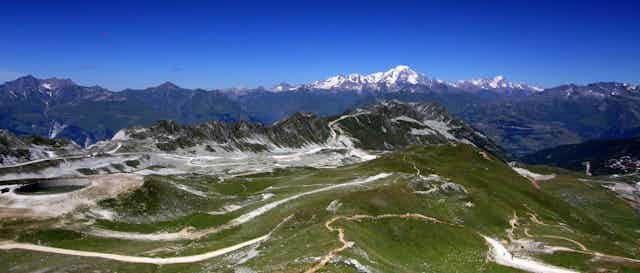Glaciers are monstrously huge pieces of ice. For millions of years their movements have eroded mountains to create some of nature’s most beautiful landscapes. But according to a new study, rather than wearing mountains down, grinding them under their weight, evidence coming from Europe’s high Alps indicates that glaciers shield the highest mountain summits from erosion, like a protective lid.
Mont Blanc is western Europe’s highest peak, sitting at the border of France and Italy. Its ownership has been a frequent point of dispute ever since the French Revolution. That didn’t concern Cécile Godon of Université de Savoie, however.
She and her colleagues studied the rates of erosion of Mont Blanc around and beneath its high glaciers. Cold glacier ice at the highest reaches sticks frozen to the mountain rock, just like your tongue will stick to a very cold ice cube. Their results, published in the journal Earth and Planetary Sciences Letters, show that the cold ice does not move significantly against the cold highest rock, and so plays little part in erosion.
The Bossons glacier flows down the northern face of Mont Blanc towards Chamonix. Godon collected rock debris carved from the mountain at the base of Bossons’ tongue and sediments washed out from erosion in high mountain streams. Similar rocks and sediments were also collected from nearby glacier-free areas.
She then compared those samples with pebbles and gravel from Mont Blanc’s lower stream beds, which are brought down the mountain in channels under the lower parts of the glacier. She found that sediments from upper parts of the mountain hardly contribute to the streams at the base of the glacier. This indicates that erosion is occurring more at the bottom but very little at the top.

These results may explain the high altitude of the Alps. Driven by the tectonic collision of Europe with Africa, the high alpine bedrock is rising at about one millimeter per year. Glacier-free areas erode at a similar rate, but where protected by ice the peaks wear at one-tenth that rate.
Fritz Schlunegger, from University Bern, Switzerland, said, “This is the first time where the protective ability of glaciers has been convincingly shown in a quantitative way and using a natural example.”
Mountain glaciers, especially those at low latitudes, are retreating across the globe in response to climate change. Earlier this year it was reported that glaciers around Mount Everest have lost more than one-eight of their area in the last 50 years, and its snow line has retreated 180 meters up the mountain. The ice cap on Kilimanjaro, the world’s highest free-standing mountain, has shrunk by more than 85% in the last century. Godon’s results suggest that changes like these could alter the shapes of the world’s highest mountains, and that climate and mountain landscape are intimately linked.

